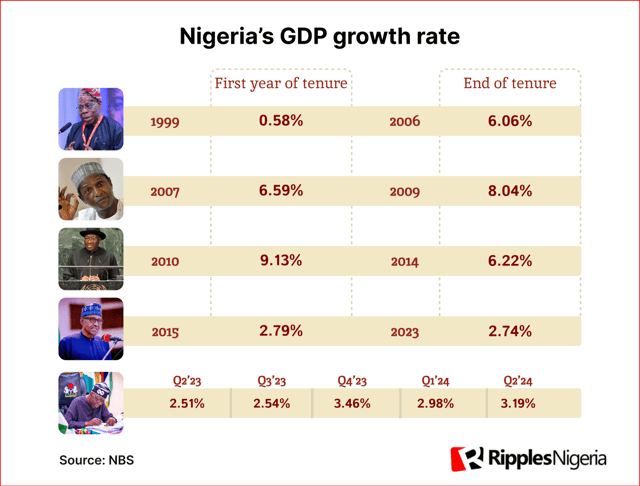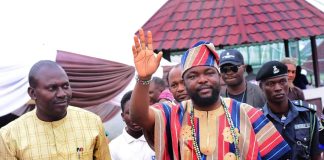🌿 Ruzu Non-Alcoholic Herbal Bitters
Ruzu Non-Alcoholic Herbal Bitters is a natural health supplement specially formulated to:
- ✅ Promote general wellness
- ✅ Detoxify the body
- ✅ Support the treatment of various ailments
Made from a powerful blend of 100% organic and medicinal herbs, Ruzu is completely alcohol-free, making it ideal for:
- 👪 All age groups
- 🌱 Health-conscious individuals
- 🌿 Anyone seeking non-alcoholic herbal remedies
Whether you're looking to boost your vitality, cleanse your system, or support healing the natural way, Ruzu Bitters offers a trusted herbal solution.
In May 2023, while President Bola Tinubu was giving his inaugural address as he assumed office as the 16th democratic president of the country, he promised to kickstart economic reforms that would increase the country’s Gross Domestic Product (GDP) figures to a target of six per cent annually.
He said, “My administration must create meaningful opportunities for our youth. We shall honour our campaign commitment of one million new jobs in the digital economy. We shall remodel our economy to bring growth and develop the GDP much better than we have seen through job creation, food security, and an end to extreme poverty.”
The speech came on the bank of his plans to grow Nigeria’s economy from $450 million Gross Domestic Product to $1 trillion in eight years, during his presidential campaign.
To achieve this, the president stirred the economy by immediately announcing the removal of fuel subsidies during his speech; a policy that has been reported to have skyrocketed the prices of goods and transportation over one year after the announcement was made.
Although experts have questioned the feasibility of Tinubu meeting his target, this report by RipplesMetrics explains why it might be difficult to achieve this target by the president up until his administration ends in 2027.
A recent report by the National Bureau of Statistics showed that the country’s GDP for the second quarter of 2024 grew by 3.19 per cent. This is up from 2.51 per cent recorded in the second quarter of 2023 and the 2.98 per cent growth seen in the first quarter of 2024.
This is the third increase, by quarter, reported under the current administration since he assumed office.
The GDP performance in Q2 2024 was primarily driven by the Services sector, which grew by 3.79 per cent and contributed 58.76 per cent to the total GDP. It was followed by the Agricultural sector which contributed 22.61 per cent and the Industry sector which contributed 18.62 per cent to the real GDP.
READ ALSO:RipplesMetrics: Nigeria approved N58.57 billion on presidential aircraft in four years
By this data, on average, Nigeria’s GDP has neared 3.09 per cent in the first six months of 2024, which translates that the president would need to enact policies and fiscal reform that would increase the GDP by an additional three per cent before the end of 2024.
For this to happen, more value on export need to increase as against importation. The last data from NBS showed that between April 2023 and March 2024, Nigeria pulled a total trade value of N85.69 trillion, with an import value of N37.03 trillion and an export value of M48.65 trillion.
Amidst these challenges, Nigeria’s inflation rate consecutively increased for 13 months under the current administration which created a major challenge for local production and consumption of products.
Nigeria’s GDP in past years
Ripples Metrics went further to check the GDP figures in nine years and learnt that since 2015, Nigeria had never exceeded 3.4 per cent. Infact, data showed that the last time Nigeria had a GDP of over 6 per cent was under former President Goodluck Johnathan in 2014.
Under former President Olusegun Obasanjo, the country’s GDP grew from 0.58 per cent in 1999 to 15 per cent in 2002 and regulated around six per cent when he left office in 2006.
Upon the assumption of late President Umaru Yar’adua, the GDP was 6.59 per cent and increased to 8.04 per cent in 2009. Meanwhile, Jonathan who grew the GDP to 9.13 per cent in 2010 had to decline in subsequent years but was able to regulate the rate to 6.22 per cent before he left office.
Unfortunately, under former President Muhammadu Buhari, the country’s GDP fell to 2.79 per cent in 2015 and consequently dropped with his administration recording two economic recessions up until 2023 when the GDP was 2.74 per cent.
By: James Odunayo
The post RipplesMetrics: Can Tinubu achieve annual GDP target. What does data says? appeared first on Latest Nigeria News | Top Stories from Naomisophyblog.
















